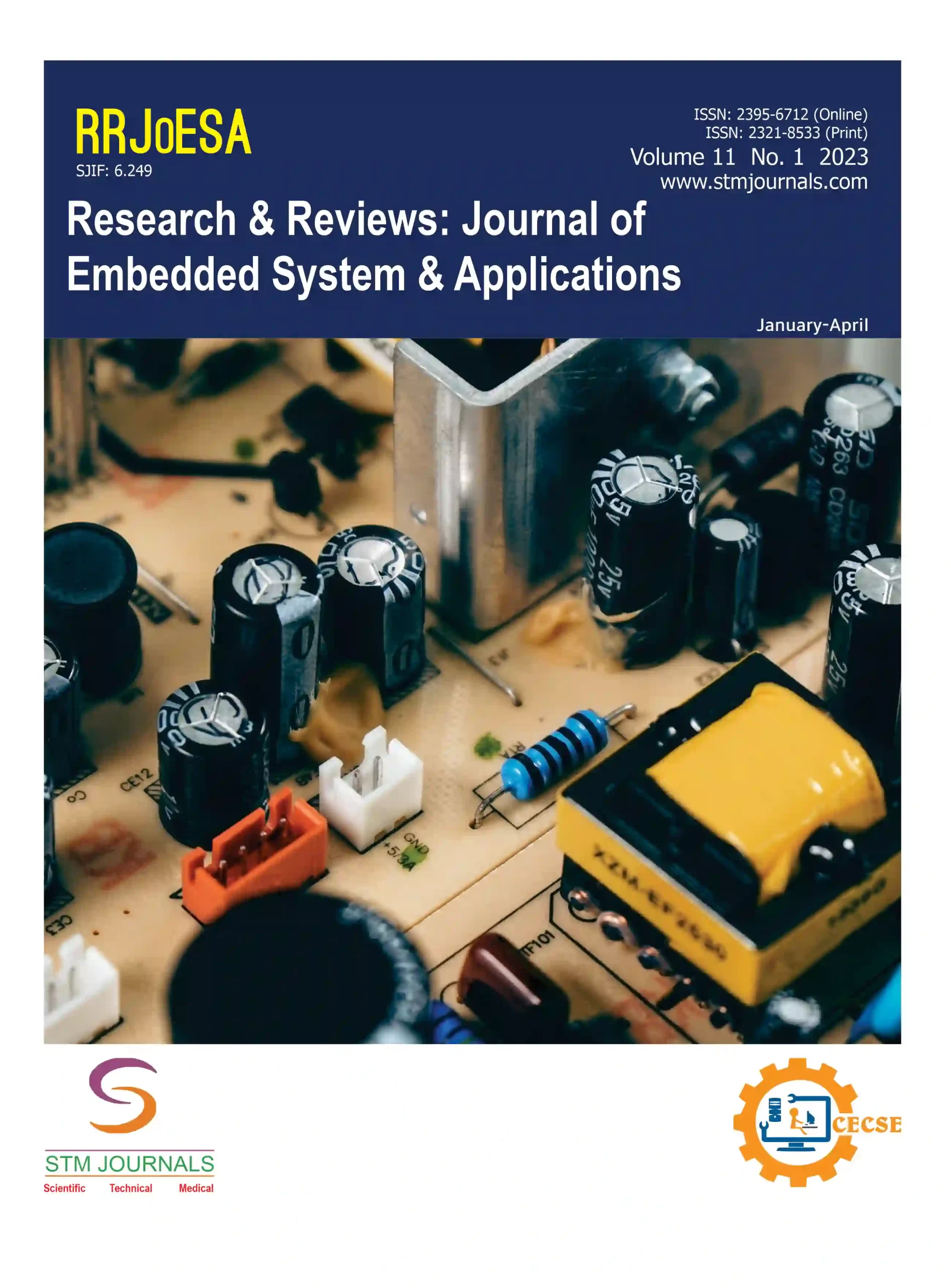[{“box”:0,”content”:”[if 992 equals=”Open Access”]
Open Access
n
[/if 992]n
n
n
n
n
- n t

n
Titus George, G. Soniya Priyatharsini
[/foreach]
n
n
n[if 2099 not_equal=”Yes”]n
- [foreach 286] [if 1175 not_equal=””]n t
- Student, Associate Professor, Department of CSE, SRM INSTITUTE OF SCIENCE AND TECHNOLOGY, Ramapuram, Chennai, Department of CSE, Dr. MGR Educational and Research university, Maduravoyal, Chennai, Tamil Nadu, Tamil Nadu, India, India
n[/if 1175][/foreach]
[/if 2099][if 2099 equals=”Yes”][/if 2099]nn
Abstract
nSoil fertility is of paramount importance in agriculture, as it directly impacts the capacity of plants to flourish and develop. Recent advancements in technology, such as soil sensors and Arduino, offer effective means to assess soil nutrients. Key nutrients for agriculture, including nitrogen, phosphorous, and potassium, are vital for plant development and are considered primary contributors to soil fertility. Monitoring these nutrients enables farmers to gauge the specific needs of the soil and determine the appropriate amount to enhance fertility. By utilizing proposed Nitrogen Phosphorous Potassium (NPK) Sensors, this method facilitates the rapid and accurate measurement of soil fertility. While various methods exist for assessing soil nutrients, the appeal of NPK sensors lies in their cost- effectiveness and practicality. Nitrogen, potassium, and phosphorus are very well-known and vital minerals for plant growth. Correct ratios of these minerals boost plant growth but due to less scientific knowledge farmers, use these minerals mindlessly which results in wastage of these minerals and this also results in pollution. IoT can give precise information on how much nutrients are really necessary. This paper explores the analysis and comparison of soil nutrient levels through the application of the kernel density estimation algorithm and machine learning approaches, providing valuable insights into soil health for informed agricultural practices.
n
Keywords: Soil nutrients, NPK Sensor, machine learning, Kernel density, Sensor
n[if 424 equals=”Regular Issue”][This article belongs to Research & Reviews: A Journal of Embedded System & Applications(rrjoesa)]
n
n
n
n
n
n
n[if 992 equals=”Open Access”] Full Text PDF Download[else] nvar fieldValue = “[user_role]”;nif (fieldValue == ‘indexingbodies’) {n document.write(‘Full Text PDF‘);n }nelse if (fieldValue == ‘administrator’) { document.write(‘Full Text PDF‘); }nelse if (fieldValue == ‘rrjoesa’) { document.write(‘Full Text PDF‘); }n else { document.write(‘ ‘); }n [/if 992] [if 379 not_equal=””]n
Browse Figures
n
n
n[/if 379]n
References
n[if 1104 equals=””]n
[1] Madhumathi, R., T. Arumuganathan, and R. Shruthi. & Soil NPK and Moisture analysis using Wireless Sensor Networks.& 11th International Conference on Computing, Communication and Networking Technologies (ICCCNT). IEEE, 2020.
[2] Muhammed Ayaz,Mohammad Ammad Uddin, Zubair Sharif, AliMansour, El-Hadi,M.Aggoune, “Internet-of-Things (IoT)-Based Smart Agriculture: Toward Making the Fields Talk”IEEE ,2019,Vol.7,129551-129583.
[3] Muthumanickam Dhanaraju, Poongodi Chenniappan, Kumaraperumal Ramalingam, Sellaperumal Pazhanivelan, Ragunath Kaliaperumal, “Smart Farming: Internet of Things (IoT)-Based Sustainable Agriculture”, Agriculture,2022 Vol.12(10)
[4]A.A.Raneesha Madu Shanki, Malka. N.Halgamuge, W.A.H.Surangi Wirasagoda, Ali Syed, “Adoption of the Internet of Things (IoT) in Agriculture and SmartFarming towards Urban Greening: A Review”, International Journal of Advanced Computer Science and Applications(IJACSA), Volume 10 Issue 4, 2019.
[5]Channe, Hemlata, Sukhesh Kothari, and Dipali Kadam. & Multidisciplinary model for smart agriculture using internet-ofthings (IoT), sensors, cloud-computing, mobile-computing & bigdata analysis.& Int. J. Computer Technology & Applications 6.3 (2015): 374-382.
[6]. T.Rajesh, Y.Thirnayana, D.Srinivasulu,”IoT based smart agriculture monitoring system” ,International Research Journal of Engineering and Technology (IRJET).
[7].Kassim, Mohamed Rawidean Mohd. & Iot applications in smart agriculture: Issues and challenges.& 2020 IEEE conference on open systems (ICOS). IEEE, 2020.
[8]Madhumathi R, “Elucidating Farmers towards SmartAgricultural Farm Building through Cloud Model”,International Conference on Computing, Communicationand Networking Technologies (ICCCNT), IEEE, 2019.
[9]Abou Bakar Bin Mushtaq, Muhammad Ammar, Hassan Ali,” IOT Based Smart Agriculture Monitoring System”, Thesis for: BSC Electrical Engineering Technology
[10.] Sivakumar Sivagami, Dr.V.Ramya, “Environmental framework for soil sampling using Iot”International Journal of Engineering and Advanced Technology 9(2):4999-5003,2019
nn[/if 1104][if 1104 not_equal=””]n
- [foreach 1102]n t
- [if 1106 equals=””], [/if 1106][if 1106 not_equal=””],[/if 1106]
n[/foreach]
n[/if 1104]
nn
nn[if 1114 equals=”Yes”]n
n[/if 1114]
n
n

n
Research & Reviews: A Journal of Embedded System & Applications
n
n
n
n
n
n
| Volume | 12 | |
| [if 424 equals=”Regular Issue”]Issue[/if 424][if 424 equals=”Special Issue”]Special Issue[/if 424] [if 424 equals=”Conference”][/if 424] | 01 | |
| Received | March 18, 2024 | |
| Accepted | March 27, 2024 | |
| Published | April 4, 2024 |
n
n
n
n
n
nn function myFunction2() {n var x = document.getElementById(“browsefigure”);n if (x.style.display === “block”) {n x.style.display = “none”;n }n else { x.style.display = “Block”; }n }n document.querySelector(“.prevBtn”).addEventListener(“click”, () => {n changeSlides(-1);n });n document.querySelector(“.nextBtn”).addEventListener(“click”, () => {n changeSlides(1);n });n var slideIndex = 1;n showSlides(slideIndex);n function changeSlides(n) {n showSlides((slideIndex += n));n }n function currentSlide(n) {n showSlides((slideIndex = n));n }n function showSlides(n) {n var i;n var slides = document.getElementsByClassName(“Slide”);n var dots = document.getElementsByClassName(“Navdot”);n if (n > slides.length) { slideIndex = 1; }n if (n (item.style.display = “none”));n Array.from(dots).forEach(n item => (item.className = item.className.replace(” selected”, “”))n );n slides[slideIndex – 1].style.display = “block”;n dots[slideIndex – 1].className += ” selected”;n }n”}]

